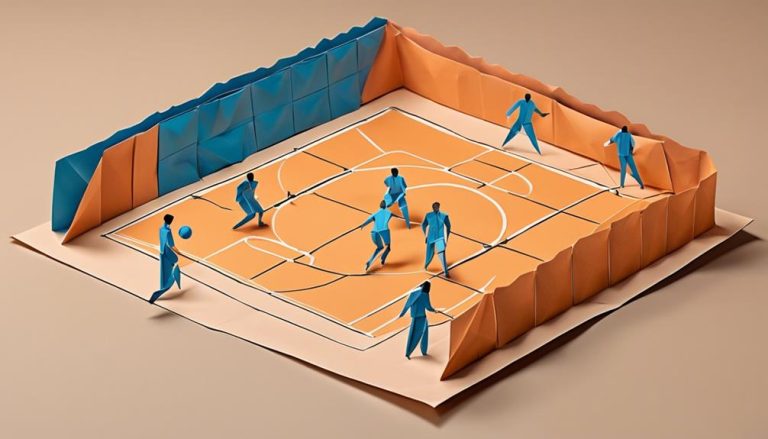General Rules of Mini Rugby
When coaching mini rugby, it is essential to emphasize the importance of fair play and sportsmanship. Imagine a scenario where a player unintentionally commits a foul during a match. What should be the proper course of action in such a situation? Understanding the rules and regulations governing mini rugby not only assures a safe environment but also teaches valuable life lessons to young athletes. As you navigate through the various aspects of the game, keep in mind the significance of following the guidelines to promote a positive and enjoyable experience for all participants.
Pitch Size and Dimensions
To properly set up a game of mini rugby, make sure that the pitch is within the specified dimensions as outlined in the rules. The pitch size for mini rugby is smaller compared to the standard rugby field. It typically measures around 60 meters in length and 35 meters in width. Ensuring the pitch is correctly marked and maintained is vital for the smooth running of the game.
Lineout strategies play a significant role in mini rugby. Teams should practice various set plays to maximize their chances of winning possession during lineouts. Effective communication and coordination among players are essential for successful execution. Coaches should drill players on different lineout scenarios to be prepared for any situation during the game.
When it comes to ruck and maul tactics, teams must focus on quick and efficient breakdown drills. Players need to understand their roles in securing possession or contesting for the ball. Developing techniques to clear out opponents from the ruck area and forming a solid maul can give your team a competitive edge.
Team Composition and Player Numbers
In mini rugby, team composition and player numbers play an important role in determining the dynamics of the game and the strategic approach that teams should adopt. It is essential to understand the guidelines surrounding player numbers and the responsibilities of team members to guarantee a smooth and efficient gameplay experience. Below is a table outlining the standard player numbers and positions in mini rugby:
| Position | Player Number | Responsibilities |
|---|---|---|
| Front Row | 1, 2, 3 | Primary in scrums and lineouts |
| Second Row | 4, 5 | Support in set pieces |
| Back Row | 6, 7, 8 | Involved in both attack and defense |
| Half Backs | 9, 10 | Link forwards and backs |
| Backs | 11-15 | Speed, agility, and scoring |
Player substitutions and rotation are crucial strategies employed by teams to keep players fresh and maintain a high level of performance throughout the game. It is the team captain's responsibility to lead by example, make strategic decisions on the field, and ensure effective communication among team members. A good team captain embodies leadership qualities, motivates the team, and fosters a spirit of unity and sportsmanship. By adhering to the player numbers, positions, and roles, teams can enhance their overall performance and competitiveness on the mini rugby field.
Scoring Methods and Points System
Understanding the scoring methods and points system in mini rugby is fundamental for teams to effectively track and maximize their performance on the field. In mini rugby, scoring techniques and point allocation play a vital role in determining the outcome of the game. Here are some key points to bear in mind:
- Try: A try is the most valuable scoring method in mini rugby, earning a team 5 points. It involves touching the ball down past the opponent's try line.
- Conversion: After a try, a team has the opportunity to score an additional 2 points by kicking the ball through the posts.
- Penalty Kick: When awarded a penalty, teams can opt to kick for goal, earning 3 points if successful.
- Drop Goal: Another method of scoring is the drop goal, where a player kicks the ball through the posts during open play, earning 3 points.
- Game Strategy: Understanding the point allocation for each scoring method is essential for developing effective game strategy. Teams must strategize when to aim for a try, when to settle for a penalty kick, and how to maximize their points.
In mini rugby, defensive tactics also heavily rely on understanding the points system. Teams must balance offensive plays with defensive strategies to prevent the opposing team from scoring and accumulating points. Mastering the scoring methods and points system is key to success on the mini rugby field.
Tackling Rules and Safety Measures
When it comes to tackling in mini rugby, it's important to emphasize proper technique to guarantee safety for all players involved. Equip yourself with the necessary gear like mouthguards and headgear to reduce the risk of injury during tackles. Familiarize yourself with referee signals that indicate when a tackle should stop to maintain a fair and safe gameplay environment.
Proper Tackling Technique
For successful tackling in mini rugby, ensuring proper technique is essential to maintain safety on the field. When it comes to tackling, follow these key points:
- Low Body Position: Bend your knees and get low to the ground to generate power.
- Head Placement: Keep your head behind the ball carrier to avoid injury.
- Shoulder Contact: Aim to make contact with your shoulder, not your head.
- Wrap Up: Secure the ball carrier by wrapping your arms around their legs.
- Drive Through: After contact, drive your legs to propel the opponent backward.
Equipment for Safety
To ensure maximum safety during tackling in mini rugby, proper equipment plays a critical role in protecting players and reducing the risk of injuries. When it comes to equipment for safety in rugby, two key elements are helmet safety and mouthguards. Helmets provide protection for the head, especially during contact situations, while mouthguards help prevent dental injuries and concussions. It is essential for players to wear the appropriate protective gear, including headgear, to minimize the impact of collisions during tackles. Ensuring that all players have the necessary equipment and that it fits properly is essential for their safety on the rugby field. Remember, safety should always come first in mini rugby to promote a secure and enjoyable playing environment.
Referee Signals for Stop
Proper execution of referee signals is imperative in mini rugby to guarantee the swift and accurate enforcement of tackling rules and safety measures. Referee signals serve as essential communication techniques to make sure the smooth running of the game and the protection of players. Here are some key signals to look out for:
- Blow the Whistle: Indicates a stoppage in play.
- Arms Crossed Above Head: Signals a high tackle or dangerous play.
- Hand Pointing to Touchline: Indicates the ball has gone out of bounds.
- Tapping Shoulder: Signals a knock-on or forward pass.
- Hand Signal Towards Bench: Indicates a substitution or injured player leaving the field.
Understanding and responding promptly to these signals is critical for maintaining a safe and fair game environment.
Equipment Requirements and Gear
When gearing up for mini rugby matches, make sure that your equipment meets the safety standards mandated by the sport's governing bodies. Proper gear maintenance is vital to guarantee your equipment is in good condition. Check your gear regularly for any signs of wear and tear, and replace or repair any damaged items promptly.
Sizing is key when it comes to equipment in mini rugby. Ill-fitting gear can not only be uncomfortable but also pose a safety hazard. Make sure your headgear, mouthguard, shoulder pads, and boots fit you properly to provide the best protection and performance on the field.
Customizing your equipment to suit your needs can give you an edge in the game. Some brands offer customization options for items like mouthguards and boots, allowing you to tailor them to your preferences. Research different brands to find the ones that offer customization features that align with your playing style and requirements.
Investing in high-quality gear from reputable brands is essential for your safety and performance. Opt for brands known for their durable and reliable rugby equipment. While it may require a higher initial investment, quality gear is a worthwhile investment in your development as a mini rugby player. Remember, your gear is your armor on the field, so choose wisely.
Offside Rule and Positioning
When playing mini rugby, understanding the offside rule is essential. Make sure your positioning on the field adheres to the regulations to avoid penalties. Utilize tactical offside strategies to gain an advantage over your opponents.
Offside in Mini Rugby
Understanding the concept of offside in mini rugby involves precise positioning on the field and adherence to the offside rule to guarantee fair play and strategic gameplay. In mini rugby, being offside can lead to penalties and consequences that can impact the flow of the game. To avoid offside situations, consider the following:
- Maintain a position behind the last feet in a ruck or maul.
- Stay behind the teammate who first played the ball from a breakdown.
- Avoid advancing in front of a teammate who kicks the ball forward.
- Refrain from joining a new phase of play from an offside position.
- Position yourself carefully to exploit offside tactics and gain advantages in defense and attack.
Player Positioning Tips
To guarantee proper player positioning in mini rugby while following the offside rule, focus on maintaining strategic placement on the field at all times. Defensive strategies are vital in ensuring each player understands their role in the defensive line. Players should maintain a straight line across the field, ensuring they are behind the offside line until the ball is played. Communication is key to avoid players being caught offside. On the offensive end, effective team coordination is essential. Players need to understand their roles within the team and be ready to support each other in different plays. By following these positioning tips, players can maintain a strong defensive line and execute successful offensive plays in mini rugby.
Tactical Offside Strategies
For guaranteed execution of tactical offside strategies in mini rugby, precise player positioning in accordance with the offside rule is key. When it comes to defensive strategies, positioning your players strategically can give your team a competitive edge. Here are some key points to ponder****:
- Maintain a Flat Defensive Line: Make sure your players are evenly spread across the field to cover potential attacking options effectively.
- Use the Offside Line: Urge your team to retreat behind the offside line quickly to pressurize the opposition.
- Watch for Offside Traps: Beware of unintentional offside positions that may give the opponents an advantage.
- Employ Decoy Runs: Incorporate deceptive moves to confuse the opposition and create attacking opportunities.
- Communicate Effectively: Ensure clear communication among players to adjust positioning promptly.
Refereeing and Fair Play Guidelines
Guarantee all players adhere to the established rules and fair play guidelines set forth by the governing body of mini rugby to maintain the integrity of the game. Fair play etiquette and refereeing are essential aspects of mini rugby that guarantee a safe and enjoyable experience for all participants. Upholding sportsmanship guidelines and officiating techniques is vital to promote fairness and respect on the field.
To emphasize the importance of fair play and proper refereeing in mini rugby, refer to the table below:
| Fair Play Guidelines | Refereeing Techniques |
|---|---|
| – Respect opponents | – Ensure player safety |
| – Play by the rules | – Consistent decisions |
| – Accept officials' calls | – Clear communication |
| – Shake hands post-game | – Manage game tempo |
| – Support teammates | – Apply advantage rule |
Frequently Asked Questions
Can Mini Rugby Players Wear Any Type of Footwear on the Pitch?
You should wear appropriate footwear for mini rugby. Cleats designed for rugby provide grip, stability, and reduce the risk of slipping. Proper footwear enhances performance, prevents injuries, and guarantees safety on the pitch.
Are There Any Specific Rules Regarding Substitutions in Mini Rugby?
In mini rugby, substitution rules are vital for game strategies. Player rotations impact team dynamics, ensuring fresh legs and strategic changes. Coaches must plan substitutions wisely to maintain momentum and adapt to the game flow effectively.
How Are Disputes or Disagreements Between Players or Coaches Resolved During a Mini Rugby Match?
In the heat of a mini rugby match, when disagreements arise, remember the golden rules of fair play and sportsmanship. Conflict resolution is key; communicate respectfully, listen, and seek understanding to maintain harmony on the field.
Are There Any Restrictions on the Use of Protective Gear or Equipment in Mini Rugby?
When playing mini rugby, you must adhere to safety regulations regarding protective gear. The types of headgear and mouthguards are very important for your protection. There are restrictions on certain equipment to make sure a safe and fair game.
Is There a Minimum Age Requirement for Participating in Mini Rugby?
To participate in mini rugby, there's typically a minimum age requirement to guarantee safety and proper player development. Adhering to age eligibility rules enhances team dynamics by grouping players of similar maturity and skill levels.






